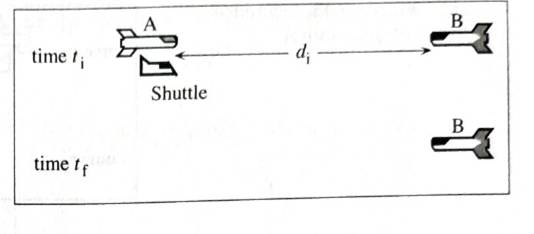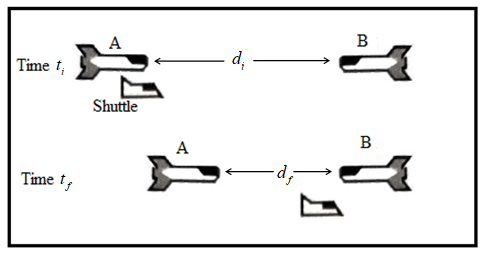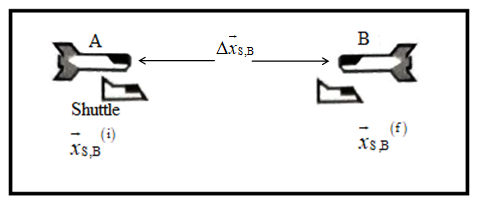
The second diagram at right shows the positions of spaceships A, B, and the shuttle at time
Sketch spaceship A and the shuttle at their positions at time
Explain how the diagram is consistent with the fact that in its own frame of reference, spaceship B is not moving.
Diagram for refrence frame of spaceship B

In the box at right, draw and label vectors for the following quantities:

•
•
•
Is the quantity
• a single instant in time or an interval of time? Explain.
• the distance between two objects or the distance traveled by a single object? Explain.
Describe how you could use
To Draw: Spaceship A and the shuttle at their positions at time
The vectors of the following quantities in frame of spaceship B
To Explain:Whether the diagram is consistent with the fact that in its own frame of reference spaceship B is not moving.
The use of
Answer to Problem 1aT
The diagram is consistent with the fact that in its own frame of reference spaceship B is not moving. The quantity
Explanation of Solution
Introduction:
Spaceship A and B are moving towards each other and spaceship A releases the shuttle at time
Spaceship A and the shuttle at their positions at time

The diagram is consistent with the fact that in its own frame of reference spaceship B is not moving as the body appears to be at rest with its own frame of reference.
Diagram having following quantities

Here,
The quantity
Here,
Conclusion:
Thus, the diagram is consistent with the fact that in its own frame of reference spaceship B is not moving. The quantity
Want to see more full solutions like this?
Chapter 1 Solutions
Tutorials in Introductory Physics
Additional Science Textbook Solutions
The Cosmic Perspective Fundamentals (2nd Edition)
College Physics: A Strategic Approach (3rd Edition)
Cosmic Perspective Fundamentals
Conceptual Physics (12th Edition)
The Cosmic Perspective
Essential University Physics: Volume 1 (3rd Edition)
- I need only number 1 and 2 revise. The red color comment is written by my professor. *Please write your explain and tell me where I'm wrong and what did you change. Thank you 1. A rocket is moving at 1/4 c relative to Earth. At the center of this rocket, a light source suddenly flashes. To an observer at rest in the rocket a. the light pulse will reach the front of the rocket at the same instant that it reaches the back of the rocket. b. the light pulse will reach the front of the rocket before it reaches the back of the rocket. c. the light pulse will reach the front of the rocket after it reaches the back of the rocket. 2. A rocket is moving at 1/4 c relative to Earth. At the center of this rocket, a light source suddenly flashes. To an observer at rest on Earth a. the light pulse will reach the front of the rocket at the same instant that it reaches the back of the rocket. b. the light pulse will reach the front of the rocket before it reaches the back of the rocket. c. the light…arrow_forwardplease help: A rectangular painting is 112 cm wide and 77.4 cm high, as indicated below At what speed, v, must the painting move parallel to its width if it is to appear to be square? Express your answer to three significant figures.arrow_forwardI am struggling with getting the following done and would greatly appriciate some help, pls explain and mnake sure your answer is correct 100% pls and thank you Answer the following parts for the relativity Question Part A. An electron has a total energy of 5.8×105eV. What is its speed? Express your answer with the appropriate units. Part B Derive an expression for the speed of a particle of rest mass m0 in terms of its total energy E. Part C What is the speed of a particle if its total energy is equal to twice the rest mass energy?arrow_forward
- Assuming that the field of view is flat, what is the resultant vector (yellow line) of an observer pointing his telescope starting at the Andromeda galaxy, then moving 62 units 27° S of W to Jupiter, then finally moving to Saturn 17 units 72° S of W. Express your magnitude to the nearest hundredths units, and the angle to the nearest hundredths °, following the standard cartesian plane coordinate system. Please show the complete solution and details of the process.arrow_forwardwo particles are traveling through space. At time tt the first particle is at the point (−4+t,3−3t,3+t) and the second particle is at (−12−t,19+t,−9−2t) Describe the two paths in words. Then determine if the two particles collide, cross, or neither cross nor collide. If they collide or their paths cross, indicate where.arrow_forwardRelativity Factor Equation: Can you show the algebraic steps to isolate only the speed (v)? Thank you.arrow_forward
- hi, thank you for solving this for me. could you write out the last few lines of the answer (starting from "we then have")? all the numbers so close together is making it a little difficult. thank you!arrow_forwardplease help: When parked, your car is 6.4 m long. Unfortunately, your garage is only 3.7 m long. A) How fast would your car have to be moving for an observer on the ground to find your car shorter than your garage? Express your answer as a multiple of c. B) When you are driving at this speed, how long is your garage, as measured in the car's frame of reference? Express your answer in meters.arrow_forwardTwo atomic clocks are synchronized. One is placed on a satellite, which orbits around the earth at high speed for a whole year. The other is placed in a lab and remains at rest, with respect to the earth. You may assume that both clocks can measure time accurately to many significant digits. a. Will the two clocks still be synchronized after one year? Explain your reasoning. b. Imagine that the speed of light was much slower than its actual value. How would the results of this experiment change if the speed of light was only twice the average speed of the satellite? Explain your reasoning, using a calculation.arrow_forward
- If a 10 kg mass, moving at 6 m/s to the right, hits and sticks to a 11 kg mass, moving at 8 m/s to the left, and they travel off together at the same speed, find that speed. Hint: here, the masses are moving in opposite directions, so the velocities should have opposite signs. Call "to the right" positive and "to the left" negative. Use the "hit and stick" or inelastic formula.arrow_forwardEvent A occurs before event B in a certain frame of reference. How could event B occur before event A in some other frame of reference?arrow_forwardThere is a cannon that can shoot cannonballs in opposite directions simultaneously with the same speed vc. This cannon is placed at the center of a truck moving with speed vT . Discuss whether the events of the cannonballs hitting the front and back of the truck will be simultaneous for all observers or not? Use the ideas from Galilean relativity and demonstrate your answer with the help of equations.arrow_forward
 University Physics Volume 3PhysicsISBN:9781938168185Author:William Moebs, Jeff SannyPublisher:OpenStax
University Physics Volume 3PhysicsISBN:9781938168185Author:William Moebs, Jeff SannyPublisher:OpenStax
